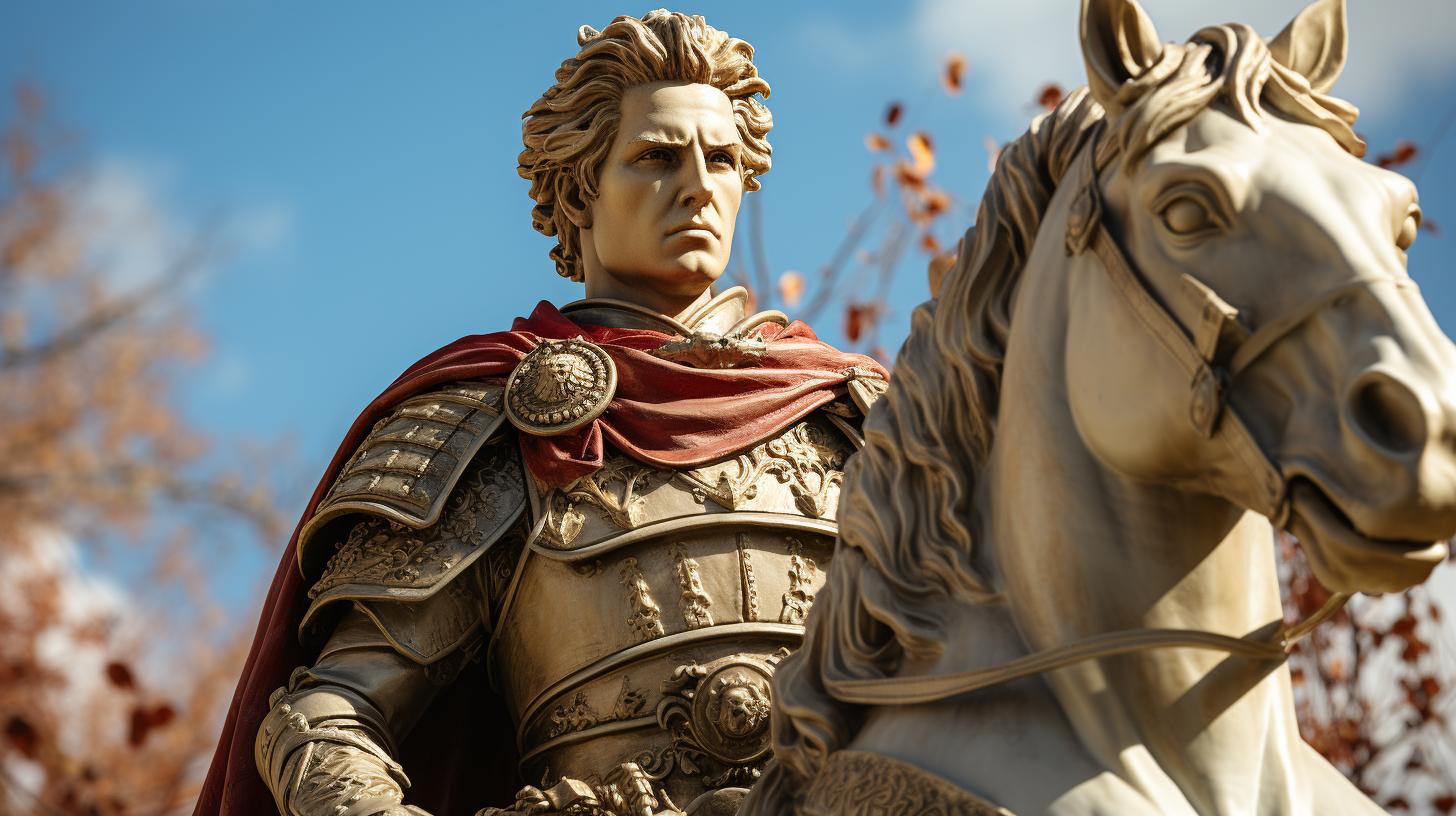The Myth of Aeneas: Exploring the Epic Journey of a Founding Hero

The myth of Aeneas holds a significant place in ancient history. Stemming from the legendary Trojan War and the fall of Troy, Aeneas emerges as a pivotal figure in both Greek and Roman mythology.
His epic journey, filled with hardships and triumphs, takes him from the ruins of Troy to the shores of Italy. Aeneas plays a crucial role in the founding of Rome, connecting his legacy to the city and its great empire.
Virgil’s renowned work, the Aeneid, further immortalizes Aeneas as an epic hero. Today, his impact can be seen in the enduring influence on Western literature, art, and various modern interpretations.
The Myth of Aeneas in Ancient History
The myth of Aeneas holds a significant place in ancient history, intertwining with both Greek and Roman mythology.
It encompasses the epic events of the Trojan War, the fall of Troy, and the legendary journey undertaken by Aeneas. This section delves into the rich tapestry of Aeneas’s story, exploring his role as a pivotal figure in ancient history.
The Trojan War and the Fall of Troy
The myth of Aeneas commences with the legendary Trojan War, a conflict between the Greeks and Trojans. The Greeks devised a cunning plan involving the construction of a massive wooden horse known as the Trojan Horse.
Meanwhile, the Trojans unsuspectingly welcomed the horse within their walls, leading to their ultimate downfall. This catastrophic event, the fall of Troy, became the precursor for Aeneas’s fateful journey.
Aeneas in Greek and Roman Mythology
Aeneas emerges as a captivating protagonist in both Greek and Roman mythology.
In Greek tales, he is portrayed as a noble and valiant warrior, the son of Anchises and Aphrodite. Roman mythology, on the other hand, elevates Aeneas to a realm of divine ancestry, tracing his lineage back to the goddess Venus (the Roman counterpart of Aphrodite). Aeneas’s divine bloodline connects him to the gods, granting him a lofty status in Roman mythology.
The Legendary Journey of Aeneas
Following the fall of Troy, Aeneas embarks on a treacherous and extraordinary journey that spans the Mediterranean. Fleeing the ruins of his homeland, Aeneas faces numerous trials and tribulations.
He navigates storms, encounters mighty foes, and endures arduous travels. This legendary odyssey ultimately leads Aeneas to the destined shores of Italy, where his role in the founding of Rome awaits.
As Aeneas’s journey unfolds, his mythic stature grows, captivating the imaginations of ancient civilizations and leaving an indelible mark on history. The tale of Aeneas transcends time, inspiring countless artistic and literary interpretations, and it continues to resonate in modern society as an enduring symbol of resilience, destiny, and the power of myth.
Aeneas: From Troy to Italy
Aeneas, the legendary hero of the Trojan War, embarked on a treacherous journey from Troy to Italy. This epic voyage marked a pivotal chapter in his life, filled with extraordinary adventures and fateful encounters.
Let’s delve into the captivating story of Aeneas as he navigated through perilous waters and faced formidable challenges on his way to establishing a new home in Italy.
Aeneas’ Escape from Troy
After the fall of Troy at the hands of the Greeks, Aeneas, guided by divine intervention, escaped the burning city with a small group of loyal companions.
They braved the dangers of a war-torn land, encountering hostile forces and overcoming countless obstacles. With his father, Anchises, and young son, Ascanius, by his side, Aeneas set sail on a fateful journey destined to shape the course of history.
Aeneas’ Encounter with Dido in Carthage
The winds of fate led Aeneas and his fleet to Carthage, where he encountered the captivating Queen Dido. Their passionate love affair unfolded against the backdrop of a city prospering under Dido’s leadership.
However, the gods, aware of Aeneas’ greater destiny, intervened, urging him to fulfill his duty and continue his journey. Reluctantly, Aeneas bid farewell to Dido, whose heartache would have far-reaching consequences.
Aeneas’ Arrival in Italy
Finally, after enduring storms and facing the wrath of vengeful deities, Aeneas reached the shores of Italy. This long-awaited destination offered both hope and turmoil as Aeneas embarked on his quest to establish a new homeland for his people.
With the guidance of the gods and alliances forged along the way, Aeneas faced rival kingdoms and engaged in epic battles, leaving an indelible mark on the Italian landscape.
Thus, the chronicles of Aeneas’ journey from Troy to Italy depict a captivating tale of resilience, love, and destiny.
Through his unwavering determination, Aeneas laid the foundation for the glorious future of his descendants and the birth of a majestic civilization that would forever shape the course of history.
Aeneas and the Founding of Rome
The myth of Aeneas holds a significant place in Roman history, intertwining with the birth and establishment of the great city of Rome.
Aeneas played a central role in Roman mythology, revered as a founding hero and ancestor of the Roman people.
Aeneas’ Role in Roman Mythology
Aeneas is considered a key figure in Roman mythology, serving as a bridge between the Trojan War and the founding of Rome. According to legend, Aeneas was a Trojan prince and the son of Anchises and the goddess Venus (or Aphrodite). He escaped the destruction of Troy and embarked on a long and perilous journey that eventually led him to the Italian peninsula.
The Connection between Aeneas and Romulus
The connection between Aeneas and Romulus, the legendary founder of Rome, is of great significance. Aeneas’ son, Ascanius (also known as Iulus), founded the city of Alba Longa, which later became the ancestral home of Romulus and Remus, the twin brothers who went on to establish Rome itself.
This lineage established a divine and heroic bloodline, linking Aeneas directly to the foundation of Rome.
Aeneas’ Legacy and Influence on Roman History
Aeneas’ legacy extends beyond his role as a mythical figure. His journey, as depicted in Virgil’s epic poem, the Aeneid, not only showcased his valor and determination but also highlighted the core values of Roman civilization.
Aeneas’ virtues of piety, duty, and loyalty became foundational pillars of Roman society and contributed to the development of Rome as a powerful empire.
The myth of Aeneas continues to impact Roman history, as it helped shape Roman identity and influenced the political and cultural narratives of the Roman Empire.
The story of Aeneas, his journey, and his descendants served as a source of inspiration for generations to come, reinforcing the importance of ancestry, heroism, and the divine origins of Rome.
The Aeneid: Virgil’s Epic Tribute to Aeneas
The Aeneid is an ancient Roman epic poem written by the poet Virgil. It serves as a grand tribute to the legendary hero, Aeneas, and his extraordinary journey from the fall of Troy to the founding of Rome.
This epic work is divided into several books, each showcasing different aspects of Aeneas’s quest and the challenges he faces.
Overview of the Aeneid
In the Aeneid, Virgil skillfully weaves together elements of Greek mythology and Roman history. The poem begins with the aftermath of the Trojan War and follows Aeneas as he escapes the ruined city of Troy and embarks on a perilous voyage across the Mediterranean.
Aeneas, guided by divine intervention, encounters various obstacles and triumphs, eventually leading him to the shores of Italy.
Themes and Symbolism in the Aeneid
- The concept of fate and divine intervention plays a prominent role in the Aeneid. Aeneas is destined to establish a new nation in Italy, and his struggles and choices are heavily influenced by the gods.
- Love and passion are explored through Aeneas’s ill-fated relationship with the Carthaginian queen, Dido.
Their tragic romance highlights the conflict between personal desires and the greater mission of destiny.
- War and its consequences are central themes in the Aeneid. Aeneas engages in various battles, embodying the ideals of heroism and illustrating the sacrifices required in the pursuit of greatness.
- The poem also touches upon the themes of loyalty, duty, and the tension between individual desires and societal obligations.
- Virgil skillfully employs symbolism throughout the Aeneid, such as the symbolic representation of Aeneas as a link between the past and future, and the imagery of flames symbolizing destruction and rebirth.
Aeneas as an Epic Hero in the Aeneid
Aeneas is portrayed as the epitome of an epic hero in the Aeneid.
He possesses exceptional strength, bravery, and leadership skills, while also displaying compassion, piety, and a sense of duty towards his people. Aeneas’s character embodies the virtues valued by ancient Roman society.
As an epic hero, Aeneas faces numerous trials and challenges, battling against both external enemies and his own internal conflicts. Despite facing hardships and temptations, he remains steadfast in his commitment to fulfill his destiny and establish a new homeland for his people.
Aeneas’s journey in the Aeneid serves as an allegory for the foundation of Rome and the triumphs and sacrifices necessary for the rise of a great empire. His character inspires readers to embrace virtues of resilience, determination, and the pursuit of a greater purpose.
The Legacy of Aeneas in World History
Exploring the impact of Aeneas on world history reveals the enduring influence of this legendary figure. From his role in shaping Roman culture to his profound impact on Western literature and art, Aeneas continues to resonate with audiences today.
Let’s delve into the various aspects of Aeneas’ legacy:
Aeneas’ Impact on Roman Culture
Aeneas holds a significant place in Roman cultural identity. As the legendary ancestor of Romulus and Remus, the founders of Rome, Aeneas symbolizes the city’s divine origins and its connection to the gods.
His story serves as a constant reminder of Rome’s glorious past and its destiny as a great empire. Aeneas’ piety, bravery, and devotion to his duty inspire Roman virtues and ethical principles, permeating through Roman society.
Aeneas’ Influence on Western Literature and Art
The myth of Aeneas has had a profound and lasting impact on Western literature and art. Virgil’s epic poem, the Aeneid, stands as a monumental work that reflects the cultural and political aspirations of Ancient Rome.
Its powerful narrative and exploration of universal themes such as duty, fate, and the challenges of human existence have inspired countless writers and artists throughout history. The Aeneid’s influence can be seen in works ranging from Dante’s Divine Comedy to Renaissance paintings depicting Aeneas’ epic journey.
Additionally, Aeneas’ story has been reimagined and adapted in various forms, including plays, operas, and films, further cementing its place in popular culture. The captivating tale of Aeneas’ trials and triumphs continues to captivate audiences across different mediums.
Modern Interpretations of the Myth of Aeneas
The myth of Aeneas has undergone reinterpretations in modern times, providing new perspectives on his journey and its relevance. Scholars and writers have explored Aeneas’ character from psychological and sociopolitical angles, shedding light on his complexities as a heroic figure.
Furthermore, Aeneas has been examined through the lens of colonialism, postcolonialism, and identity, prompting discussions on power dynamics, cultural assimilation, and the representation of marginalized voices.
The continued exploration and reinterpretation of Aeneas’ myth demonstrate its timeless nature and its ability to engage with contemporary issues and concerns.
.




















